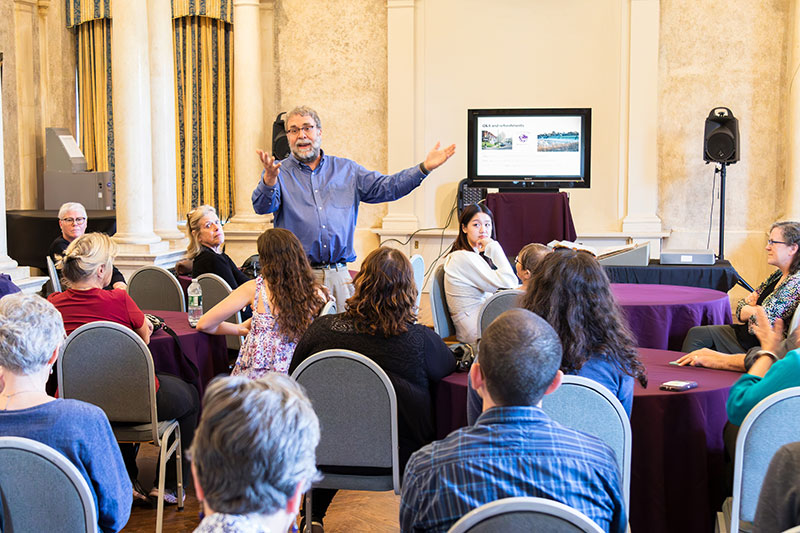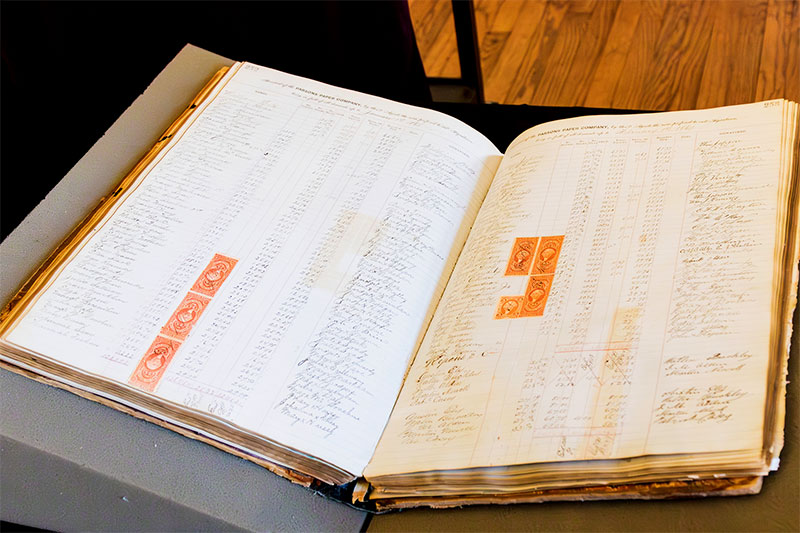“It was a fusion of both humanities and STEM,” one student wrote in their course reflection.
“An unlikely combo of data science and the history of Holyoke, Mass.,” added another.
And this from a third: “It was really cool.”
The course is Statistics 210: “Mining the History of Holyoke,” and it was taught last spring by Nicholas Horton, the Beitzel Professor in Technology and Society (Statistics and Data Science).

Professor Nick Horton speaking at the Wistariahurst Museum
Horton—who is also the vice president of the American Statistical Association—intentionally had the group work as a team, to mimic team-based data science in the workplace; and split them into pairs, to mirror the two-person system coders use when developing code; and encouraged individual research, too.
The class of six students (Sarah Edelson ’23, Camden Heafitz ’25, Kevin Jin ’23, Lorraine Oloo ’23, Nahia Pino ’25 and Anna Zhou ’25) then chose where, what and how they might dig through Holyoke history and translate their findings into analytic reports, data visualizations, interactive web apps and more.
Their efforts were supported by a grant from the Data Science Corps, part of the National Science Foundation, which encourages student data scientists to analyze data for their local nonprofit organizations. The class, said Horton, “was truly an adventure.”

The Parsons Paper Company Register
All the students dug into the 19th-century history of the Parsons Paper Co., Holyoke’s oldest and longest-running paper mill (1853-2005). In smaller groups, they also focused on the correspondence sent by two siblings to their mother back home in Holyoke between 1927 and 1953, with many letters from overseas during World War II; urban renewal in Holyoke in the 1960s; and the papers of Carlos Vega, a longtime activist in Holyoke, who founded the advocacy group Nueva Esperanza, which serves the city’s Puerto Rican/Afro-Caribbean community.
This was hands-on work, much of it conducted in Holyoke at the Wistariahurst Museum Archive, with help from Pennie Martorell (Curator and City Historian); and the Holyoke Public Library History Room, aided by Eileen Crosby (Archivist at the Holyoke History Room and Archives). At the end of the course, the students took turns presenting their findings at a public event at Wistariahurst in its lavish Belle Skinner Music Room. (You can access the full presentation here.)
The Parsons Paper Mill project took up much of the presentation. A few students had begun by paging their way through a fragile book containing several decades of the mill’s payroll registers, from before and after the U.S. Civil War.
Said Nahia Pino ’25: “Parsons became the life’s blood of this town, and we wanted to make sure this book was accessible for all of time.” They digitized pages, created tiff files and launched an interactive Github web app.
As the students accumulated more and more data, it began to tell a story. They could trace patterns of employment, for instance, and wage rates. To wit: a boy working as a cutter of paper made $6.90 a week, a girl with the same job $3.40. Illiterate employees—which the students determined by noting whose signature was just the letter X—were paid less than literate ones.

Camden Heafitz ’25 and Lorraine Oloo ’23 presenting their genealogical research
Heafitz and Oloo then did genealogical research to pin down family connections among the employees, and consulted Holyoke’s reverse directory from that time, to map where the employees lived. The students transcribed hundreds of names—which can help future researchers. “For genealogical purposes,” said Horton, “this will be gold.”
Along the way, they decoded abbreviations from the documents. “R” meant the person rented a room, for instance. “BV” connoted they lived in Holyoke’s Baptist Village neighborhood, and “DO” stood for “ditto.”
Other class members then turned to the era’s municipal reports. A public health narrative, especially, emerged. First came reports of diphtheria epidemics and then, around 1900, there appeared new government offices and positions: a board of plumbing, a city bacteriologist, and inspectors of milk, vinegar and petroleum.
“This is what truly lies at the heart of statistics,” said Horton. “It is important to always think of the human element behind all of our quantitative work.”
In one course reflection, a student was gratified to sharpen so many data science skills, including various text analysis techniques, linear discriminant analysis and sentiment analysis.
“As an added bonus,” the student added, “I learned how to read 1800s cursive pretty fluently.”